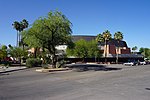McKale Memorial Center is an athletic arena in the southwest United States, located on the campus of the University of Arizona in Tucson, Arizona. As the home of the university's Wildcats basketball team of the Pac-12 Conference, it is primarily used for basketball, but also has physical training and therapy facilities. Its construction is marked with a large copper cap that has oxidized brown.
In the 1960s, it was recognized that the Wildcats' basketball venue, Bear Down Gymnasium, was outdated and in need of replacement. Major planning for the new facility began in 1966. During construction, the Wildcats briefly considered playing some of its 1971–72 home schedule in the then-newly completed 8,000-seat arena at the Tucson Convention Center, but eventually declined, remaining in Bear Down Gym until the new venue was ready. The new arena officially opened in February 1973 and has an official capacity of 14,644 spectators. The elevation at street level is approximately 2,450 feet (750 m) above sea level.
The McKale Center was named in honor of J.F. "Pop" McKale, a major athletic figure at U of A from 1914 to 1957. At one time, he was head coach of all of the school's athletic teams. He was head basketball coach from 1914 to 1921, where he achieved a 49–12 (.803) record. He led the football team from 1914 to 1930, with an 80–32–6 (.703) record. It was McKale's first team that resulted in Arizona's teams being nicknamed "Wildcats." In 1914, Arizona's name meant very little in the college football world. Although they lost to Occidental College in Los Angeles 14–0, a reporter for the Los Angeles Times was so impressed with Arizona's effort that he wrote, "The Arizona men showed the fight of wild cats ..." Soon afterward, Arizona's student-athletes were nicknamed the Wildcats.Following a win over rival Arizona State on February 26, 2000, the university athletic department honored longtime head coach Lute Olson with a ceremony to name the McKale Center playing surface "Lute Olson Court." Less than a year later, during a memorial service in January 2001 for Olson's late wife, Bobbi, it was renamed, "Lute and Bobbi Olson Court" in recognition of the couple's impact on the university and the city of Tucson.In 2002, the Eddie Lynch Athletics Pavilion, a state-of-the-art medical and strength/conditioning facility for Wildcat student athletes, was completed and opened. The pavilion (which cost $14 million) was a 36,000-square-foot (3,300 m2) addition to the north end of McKale Center. The upper level has a 10,000-square-foot (930 m2) museum-like display area, open to the public, showcasing the history of Arizona Wildcat athletics.In terms of capacity, McKale Center is the second-largest arena in the Pac-12 conference; Utah's Huntsman Center in Salt Lake City is first, but Arizona averages greater attendance. Arizona has the current longest streak of leading its conference in attendance in conference history, going on 34 seasons & second in the country currently behind Kentucky at 40.The university's spring and winter commencement ceremonies were held at McKale Center from 1973 until 2012; the 2013 ceremonies returned to Arizona Stadium after an absence of thirty years.






